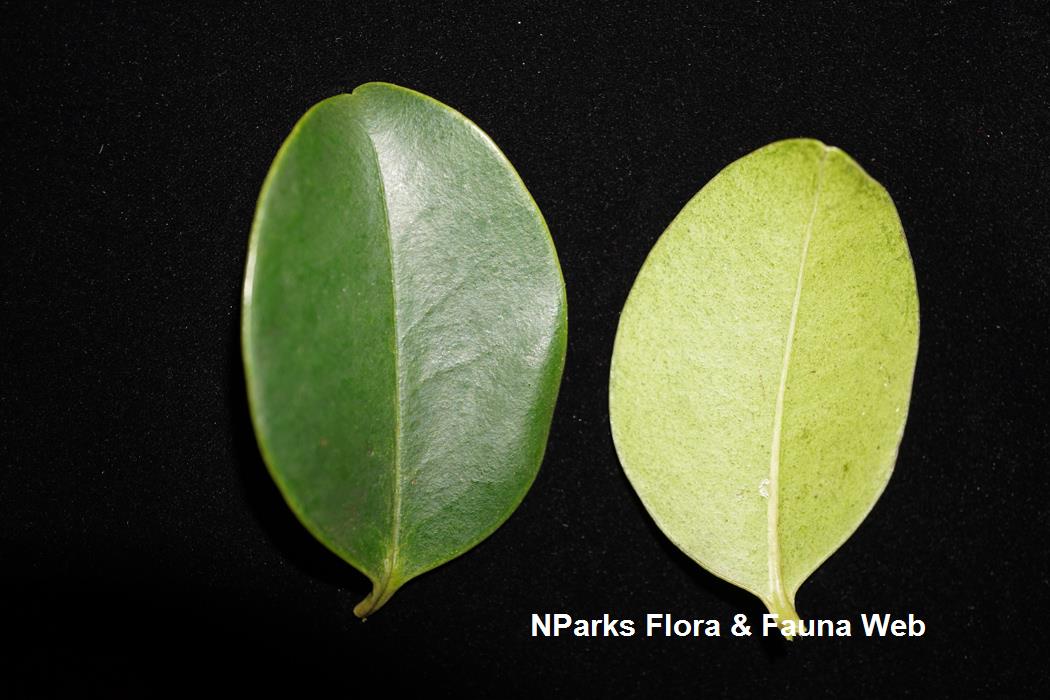
Back
Memecylon ovatum Sm.
| Family Name: | Melastomataceae |
| Synonyms: | Memecylon pierrei, Memecylon laxiflorum, Memecylon grande var. ovatum, Memecylon violaceum, Memecylon lucidum, Memecylon tinctorium, Memecylon parviflorum, Memecylon umbellatum, Memecylon rhodophyllum |
| Common Name: | Delek Air, Bayan, Phlong Kin Luuk, Ironweed Tree, Kolis |
Name
Classifications and Characteristics
| Plant Division | Angiosperms (Flowering Seed Plants) (Dicotyledon) |
|---|---|
| Plant Growth Form | Tree (Small (6m-15m), Shrubby (1m-5m)), Shrub |
| Lifespan (in Singapore) | Perennial |
| Mode of Nutrition | Autotrophic |
| Plant Shape | Shrubby |
| Maximum Height | 3 m to 12 m |
Biogeography
| Native Distribution | Philippines, Malaysia, Singapore |
|---|---|
| Native Habitat | Terrestrial (Secondary Rainforest, Coastal Forest), Shoreline (Sandy Beach) |
| Preferred Climate Zone | Tropical |
| Local Conservation Status | Native to Singapore (Endangered (EN)) |
Description and Ethnobotany
| Growth Form | Big shrub or small shrubby tree, 3-12m height, occasionally reaching 18m. |
|---|---|
| Trunk | Single or multiple. Bark greyish-brown, very thin, fissured and flakey but not ridged. |
| Foliage | Leaves opposite, ovate to elliptical, sub-leathery with indistinct veins, blades 6.3-11.4cm long by 3.8-6.3cm wide, petioles 0.6-1.3cm long, apex acute, margins upcurled. Young leaves glossy red. |
| Flowers | Small (7.62mm across), petals and stamen stalks brilliant blue, calyxes pink, barely scented, clustered into small panicle inflorescences arising directly from twigs at leaf axils. |
| Fruit | Small globular berries, with persistent calyx at base, borne in small axillary bunches, ripening from green to pinkish-red to black, eaten by birds. |
| Others - Plant Morphology | Conservation Status: Native to Singapore, endangered. (Singapore Red Data Book 2008) |
| Habitat | Occuring as thickets at coastal cliffs, on limestone, along sandy to rocky seashores. Part of foliage and/or roots often under seawater during high tide. |
| Similar | Resembles and often mistaken for Memecylon edule whose very fragrant flowers have pink petals and calyxes, topped by blue-stalked stamens; whose fruits ripen from green to yellow to black (never turning red); and whose leaves are smaller (3.8-7.6cm by 2.5-3.8cm) with bluntly-acute tips and stalks shorter than 0.6cm. Differentiated from the similarly blue-flowered Memecylon oleifolium, whose leaves have distinctly caudate (tail-like) tips. |
| Cultivation | Slow-growing. Takes full sun to bright shade. Tolerant of waterlogged, alkaline and saline soils. If grown as tree, prune periodically and remove water shoots from trunk for better form. Propagate by stem-cuttings, air-layering or seeds. |
| Etymology | Genus epithet 'Memecylon' derived from 'memaecylon' -- as used by ancient Greek philosophers Dioscorides and Pliny to describe the red fruits of Arbutus unedo (Oriental Strawberry Tree) -- alluding to the pink to reddish berries often produced by members of the 'Memecylon' genus. Species epithet 'ovatum' means 'ovate', describing the leaves of the plant. |
| Ethnobotanical Uses | Food (Herb or Spice) Others: Medicinal: Root decoction used to treat menstrual irregularities. Leaf infusion used as astringent lotion for eye inflammation. |
Landscaping Features
| Desirable Plant Features | Ornamental Flowers, Ornamental Fruits |
|---|---|
| Landscape Uses | Coastal, General, Hedge / Screening, Container Planting, Beachfront / Shoreline |
| Thematic Landscaping | Naturalistic Garden |
Fauna, Pollination and Dispersal
| Fauna Pollination Dispersal Associated Fauna | Bird-Attracting |
|---|
Plant Care and Propagation
| Light Preference | Full Sun, Semi-Shade |
|---|---|
| Water Preference | Moderate Water |
| Plant Growth Rate | Slow |
| Rootzone Tolerance | Fertile Loamy Soils, Poor Infertile Soils, Saline Soils / Salt Spray, Alkaline high pH Soils, Shallow Media |
| Maintenance Requirements | Moderate |
| Propagation Method | Seed, Stem Cutting, Air-Layering |
Foliar
| Foliage Retention | Evergreen |
|---|---|
| Mature Foliage Colour(s) | Green |
| Mature Foliage Texture(s) | Smooth, Thick |
| Prominent Young Flush Colour(s) | Red |
| Foliar Type | Simple / Unifoliate |
| Foliar Arrangement Along Stem | Opposite |
| Foliar Shape(s) | Non-Palm Foliage (Ovate) |
| Foliar Venation | Pinnate / Net |
| Foliar Margin | Entire |
| Foliar Apex - Tip | Acute |
Non - Foliar and Storage
| Trunk Type (Non Palm) | Woody |
|---|---|
| Bark Colour(s) | Greyish-Brown |
| Mature Bark Texture | Fissured |
| Stem Type & Modification | Woody |
| Root Type | Underground (Tap Root, Fibrous Root) |
Floral (Angiosperm)
| Flower & Plant Sexuality | Bisexual Flowers |
| Flower Colour(s) | Blue |
|---|---|
| Flower Symmetry | Radial |
| Flower Size - Remarks | 7.62mm across |
| Inflorescence Type | Panicle |
| Flowering Habit | Polycarpic |
Fruit, Seed and Spore
| Mature Fruit Colour(s) | Black |
|---|---|
| Fruit Classification | Simple Fruit |
| Fruit Type | Fleshy Fruit , Berry |
Image Repository
Others
| Master ID | 29685 |
|---|---|
| Species ID | 3994 |
| Flora Disclaimer | The information in this website has been compiled from reliable sources, such as reference works on medicinal plants. It is not a substitute for medical advice or treatment and NParks does not purport to provide any medical advice. Readers should always consult his/her physician before using or consuming a plant for medicinal purposes. |









